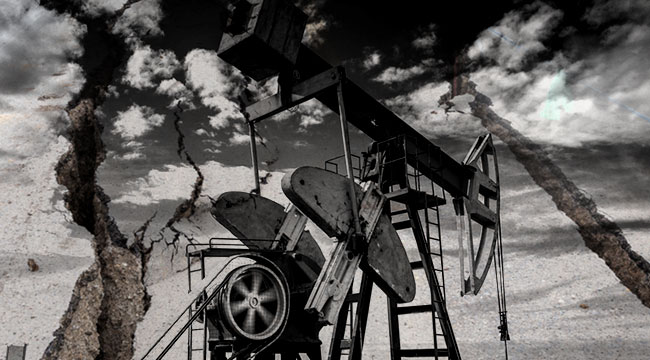
Last Saturday morning, I woke up at home in Oklahoma to a backlog of text messages, which set off an inner alarm. This prompted an assumption that some important news broke, and with a summer like this one, there’s no telling what terrible story — likely of a man-made nature — awaited. But oddly enough, a natural disaster had taken place. “You okay?” popped up several times on my screen, which prompted this sleepy thought: “Did I sleep through a tornado?”
That explanation couldn’t have been possible. The nearest sirens are only a few blocks away and would wake anyone, but tornadoes are what happens in this neck of the woods, and it’s still that season. Instead, a not insignificant earthquake — 5.6 in magnitude — struck with an epicenter about a 45-minute drive away in Pawnee, Oklahoma and rattled several states, from Texas to Missouri. Since this was a moderate quake, the localized damage included a handful of buildings that were rendered uninhabitable. The Pawnee Nation tribe subsequently declared a state of emergency, and one person required medical attention.
The news media and the Internet freaked out over the quake’s magnitude, but the damage was relatively slight because of the bedrock common to Pawnee. Geophysicist Jefferson Chang told the Associated Press about the area’s “hard, or competent bedrock,” which absorbed much of the shock and prevented a more dire outcome. Fortunately, the affected area should quickly recover. However, this may not be the case in the future, for Oklahoma has developed a serious earthquake problem.
The quake happened at around 7 a.m. CST when many people were asleep. But my Oklahoma neighbors, who were fully conscious, shrugged over the experience. The state’s residents are growing used to earthquakes, and — in a state hardened by tornadoes — indifference at perceived natural disaster is a commonplace reaction. It’s simply accepted, which is sad since these quakes should be terrifying. Since 2009, the state has been plagued by earthquake swarms with a series of sharp jumps in earthquakes every year. If we’re talking about ground shakers with a magnitude of 3.0 or above, 2014 brought 585 quakes with 2015 following up with 890 quakes. In March, the United States Geological Survey (USGS) declared that Oklahoma carries just as much earthquake risk as California does.
The difference between the two states, according to USGS and what many people have suspected, is how Oklahoma is burdened by “induced” quakes, which are “triggered by human activities, with wastewater disposal being the primary cause … wastewater from oil and gas production operations can be disposed of by injecting it into deep underground wells, below aquifers that provide drinking water.” So … fracking. Authorities have been loathe to acknowledge the correlation between Oklahoma’s fracking boom and flurries of earthquakes, but this seeming connection can no longer be ignored.
The Correlation That Can’t Be Ignored
This isn’t an in-depth essay about the oil and gas industry’s fracking, which has been the chief suspect in the recent epidemic of Oklahoma quakes. The method of extraction creates toxic wastewater, which is then injected violently deep into the earth though disposal wells that run far below the aquifers that contain drinking water. Lawmakers have been hesitant to put brakes on the practice for obvious reasons. For one thing, the fracking boom (which has been ongoing since 2008 — cough) is a highly profitable endeavor. Fortune reminds the world that President Obama once praised the practice for having “the potential to create as many as 600,000 jobs.” But at what cost? If the problem grows worse, life and limb could be sacrificed along with property.
And yet, the nation was surprised on Saturday when a 5.6 quake went down in the middle of Oklahoma. The quake tied the record for the strongest in the state with one that happened in 2011 (which I was conscious for and do remember). That quake’s epicenter was “located near several active injection wells was a magnitude 5.6 in 2011 near Prague, Oklahoma” and left much more damage in its wake than the Pawnee quake. This could be explained by Prague’s softer bedrock, which transfers the vibrations more, rather than absorbing them. The Pawnee quake caused less damage, so the state got lucky, but next time? There will be a next time.
Unexpected Attention Prompts Authorities’ Actions
In response to Saturday’s quake, state regulators have shut down 37 water disposal wells used by oil and gas drillers in the state. As CNN points out, the Oklahoma Corporation Commission suspects the wells ”may have played a role” in the quake. And commission spokesperson Matt Skinner explained to CNN what’s probably going on: “The disposal wells dispose into the state’s deepest formation, the Arbuckle formation, which is right above what we call the basement. The basement is above where the critical faults lie that shift and make earthquakes.” In addition to the shutdowns, the Environmental Protection Agency is also on the case.
The Minneapolis Star Tribune also quotes Skinner, who says the wells were (finally) shut down because of the “scientific links” between fracking water disposal and the increased earthquakes. But still, he’s hesitant to directly claim that the disposal wells caused the induced quakes: “There’s all kinds of theories as to why it puts pressure on the basement faults, but somehow that is happening and we have taken many actions based on that.”
Let’s get real, though. The mainstream media has danced around the fracking-earthquake correlation while occasionally mentioning the correlation and letting it drop. That’s understandable. A rise in moderate earthquakes isn’t nearly as exciting as the most recent celebrity who rages against Donald Trump. But this latest 5.6 quake has done some good, because — fortunately — the damage was relatively slight, albeit not welcome, with plenty of media attention devoted to the cause. The public’s attention is fleeting, but for now, perhaps current awareness of Oklahoma quakes will make a difference.

